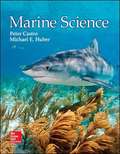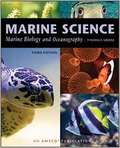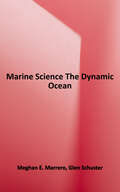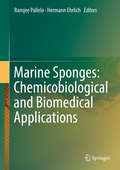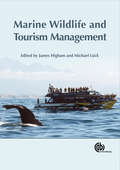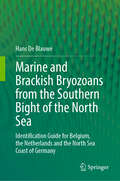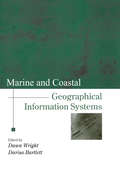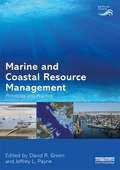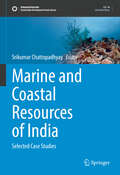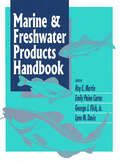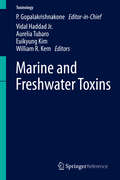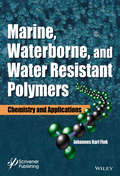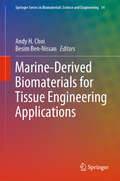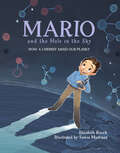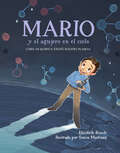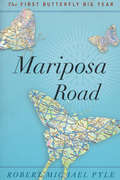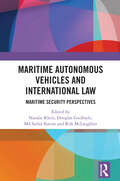- Table View
- List View
Marine Science
by Michael E. Huber Peter CastroThe first edition of Marine Science became an instant beloved text with its full coverage of oceanography, stunning design, student-friendly learning system, and data analysis labs. <p><p>Now in its second edition, the program further expands its NGSS coverage, ELL support, interdisciplinary applications, and introduces a broader focus on human and environmental interaction.
Marine Science
by Thomas F. GreeneWritten for high school students, this book provides complete coverage of a one-year high school course in marine biology/oceanography.
Marine Science (Florida Edition): The Dynamic Ocean
by Glen Schuster Meghan E. Marrero Us Satellite LaboratoryMarine Science for Kids: Exploring and Protecting Our Watery World, Includes Cool Careers and 21 Activities
by Bethanie Hestermann Josh Hestermann Stephanie ArneDo you ever dream of being a marine explorer or adventurer? Are you a fan of cool, cute, or creepy creatures? Then here's some good news: some of the coolest, cutest, and creepiest creatures live in Earth's oceans and other watery places.Marine Science for Kids is a colorful, fun, photo-filled guide to exploring our underwater world. In these pages, you'll delve deep into the science of aquatic study, including geology, chemistry, and biology in both salt- and freshwater environments, and gain insight into the real-world practice of aquatic science. You'll discover how and why oceans move, and learn the answers to questions such as "Why is the ocean blue?" You'll meet cool creatures, including sharks and rays, penguins and other seabirds, whales and dolphins, squids and octopuses, and many more. You'll uncover some of the most pressing challenges facing marine environments and find out how you can use your talents to make a difference. Real-life marine scientists share what inspires them every day and provide insights into their exciting careers. Hands-on activities in each chapter make learning fun.Kids can: make an edible coral reef; explore marine camouflage; construct a water-propelled squid; test methods of cleaning up an oil spill; experiment with ocean acidification; and much more.
Marine Science: Marine Biology and Oceanography
by Thomas F. GreeneThis book introduces the wonders of marine life and ocean environments with this engaging and fun-to-read program.
Marine Science: The Dynamic Ocean
by Glen Schuster Meghan E. MarreroThis book is a truly integrated science course in which the science concepts are applied to authentic scientific settings, scenarios, and investigations. You will simultaneously learn about life, Earth, and physical sciences. As you explore real-world data, you get a unique and fresh perspective on the ocean, its inhabitants, and its processes. Science concepts such as plate tectonics, food and energy transfer, and the properties of water come to life as you participate in Student Expert teams that focus on the seafloor, marine food sources, and the sea's surface. <p><p>This curriculum program parallels other textbook programs, yet there are some notable distinctions in the way it was put together. Rather than chapters, the book is divided into 34 Lessons, each of which will help you to build your understanding about the ocean and its processes. Marine Science: The Dynamic Ocean gives you the opportunity to access and interpret data sets, including oceanographic, meteorological, and animal tracking observations. You will also participate in fieldwork, assessing local water quality and your school's potential contribution to marine pollution.
Marine Sponges: Chemicobiological and Biomedical Applications
by Hermann Ehrlich Ramjee PallelaThe main focus of this book entitled is to provide an up-to-date coverage of marine sponges and their significance in the current era. This book is an attempt to compile an outline of marine sponge research to date, with specific detail on these bioactive compounds, and their pharmacological and biomedical applications. The book encompasses twenty chapters covering various topics related to Marine Sponges. Initial couple of chapters deal about the worldwide status of marine sponge research, the recent findings regarding dynamics of sponges, and several interesting research areas, that are believed to be deserving of increased attention. Variety of sponges, their toxicology, metagenomics, pharmaceutical significance and their possible applications in biomedicine has been discussed in detail. The second half of this part includes chapters on chemical ecology of marine sponges followed by the discussion on importance of bioeroding sponges in aquaculture systems. The following four chapters of the book deal majorly with the chemical molecules of marine sponges. In the fifth chapter, marine sponge-associated actinobacteria and their pysicochemical properties have been discussed followed by their bioactive potential. The biological application of marine sponges has been presented in later chapters with the classification of biologically active compounds being explored in detail. The second half of the book presents the vast repertoire of secondary metabolites from marine sponges, which include terpenoids, heterocycles, acetylenic compounds, steroids and nucleosides. Further, the bioactive potential of these compounds has also been discussed. One of the constituent chapter elaborates the bioactive alkaloids from marine sponges namely, pyridoacridine, indole, isoquinolene, piperidene, quinolizidine, steroidal and bromotyrosine alkaloids isolated from them. In the next couple of chapters, important sponge polymers and the anticancer effects of marine sponge compounds have been presented. The most interesting aspect of sponge biology is their use in biomedical arena. An effort has been made in this book, to cover the major constituents of sponges and their biomedical potentials. The major portion of sponge body is composed of collagen and silica and used in tissue engineering as scaffold material. This part of the book compiles chapters delineating the isolation of sponge biomaterials including collagen and their use in medical diagnostics. Overall, this book would be an important read for novice and experts in the field of sponge biology.
Marine Surfactants: Preparations and Applications
by Se-Kwon Kim Kyung-Hoon ShinThis book explores the development of novel marine biosurfactants. The book also covers the utilization of marine surfactants for biological and biomedical, and environmental applications. Marine Surfactants: Preparations and Applications aims to examine every aspect of marine derived surfactants.The first part of the book discusses the isolation of marine surfactants from various organisms include marine bacteria, algae, cyanobacteria and so on. The editors also examine the cultivation of marine microorganisms and the harvesting of other natural biological resources from the sea. The next part of the book discusses the application marine surfactants, including oil spill removal in the sea, bioremediation of polluted water and soil, treatments for breast cancer, restoration of marine environments, nanoparticles synthesis, and development of different kinds of emulsifiers. With contributions from world-renowned experts in the field, this book will be an essential resource in understanding and developing various marine-derived surfactants. This book is intended for researchers and marine biotechnologists as well as medical practitioners working on a vast range of industrial and medical applications using marine materials. It would also be useful for students looking to understand the utilization of marine derived surfactants.
Marine Wildlife and Tourism Management: Insights from the Natural and Social Sciences
by James HighamMarine environments have long been places of exploration, subsistence, transport and trade, but it is only recently that marine tourism has extended beyond coastal resorts and beaches. Demand for marine wildlife experiences has grown considerably in recent decades but a corresponding increase in the conservation of these environments as well as adequate legislative and management responses aimed at sustainability has not yet followed. This book demonstrates that through scientific approaches to understanding and managing tourist interactions with marine wildlife, sustainable marine tourism can be achieved. Drawing from disciplines such as marine and conservation biology and behavioural ecology, the effects of human disturbance on marine wildlife as well as management approaches to moderate these impacts are explored. Social science perspectives are also used to understand consumer demand and the ethical and legislative problems that this demand creates. This comprehensive volume provides valuable insights for both researchers and practitioners in marine conservation and tourism.
Marine and Brackish Bryozoans from the Southern Bight of the North Sea: Identification Guide for Belgium, the Netherlands and the North Sea Coast of Germany
by Hans De BlauweIn 2009, Hans published a Dutch identification guide for marine and brackish water Bryozoans (&“moss animals&”) of the Southern Bight of the North Sea, illustrated with drawings, scanning-electron and light microscope images. It is a reliable reference for professional bryozoologists and keen amateur naturalists studying northern European bryozoans. This virtually complete inventory of a group of animals that have been the object of very few studies so far, but that encompasses a surprisingly large variety of species. The sandy substrate that is predominant in this area is usually poor in moss animal species. The fact that such a large number of species are described in this work is the result of an in-depth study of recent observations (tidemark material, specimens collected on the hard substrate of breakwaters and port structures, shells and stones near sandbanks) and the review of historical collections. As many as 179 species were discussed in the Dutch book, the present English update treats 201 species, describing 9 species as new to science. The area bounded to the south by Cap Gris Nez (Northern France) covers the Belgian and Dutch coast and is now extended to the German North Sea coast. This update includes more native and non-indigenous species, new distribution data, new taxonomic insights, additional references, and additional or better illustrations. What is especially remarkable is that each species has been illustrated using both stereomicroscope showing natural coloration and colony shape, and scanning electron microscope showing small details of zooidal morphology. Thanks to the different identification keys in the book and a 20-30x magnifying glass, it is possible to recognize most of the moss animals in the study area. We hope that this work will contribute to a better understanding of this colony-forming, undervalued group of animals.
Marine and Coastal Geographical Information Systems (Research Monographs In Gis Ser.)
by Dawn J. Wright Darius J. BartlettMarine and coastal applications of GIS are finally gaining wide acceptance in scientific as well as GIS communities, and cover the fields of deep sea geology, chemistry and biology, and coastal geology, biology, engineering and resource management. Comprising rigorous contributions from a group of leading scholars in marine and coastal GIS, this book will inspire and stimulate continued research in this important new application domain.Launched as a project to mark the UN International Year of the Ocean (1998) and supported by the International Geographical Union's Commission on Coastal Systems, this book covers progress and research in the marine and coastal realms, in the areas of theory, applications and empirical results. It is the first book of its kind to address basic and applied scientific problems in deep sea and coastal science using GIS and remote sensing technologies. It is designed for GIS and remote sensing specialists, but also for those with an interest in oceans, lakes and shores. Coverage ranges from seafloor spreading centres to Exclusive Economic Zones to microscale coastal habitats; and techniques include submersibles, computer modelling, image display, 3-D temporal data visualization, and development and application of new algorithms and spatial data structures. It illustrates the broad usage of GIS, image processing, and computer modelling in deep sea and coastal environments, and also addresses important institutional issues arising out of the use of these technologies.
Marine and Coastal Resource Management: Principles and Practice (Earthscan Oceans)
by David R. Green Jeffrey L. PayneIn this new and highly original textbook for a range of interdisciplinary courses and degree programmes focusing on marine and coastal resource management, readers are offered an introduction to the subject matter, a broad perspective and understanding, case study applications, and a reference source. Each chapter is written by an international authority and expert in the respective field, providing perspectives from physical and human geography, marine biology and fisheries, planning and surveying, law, technology, environmental change, engineering, and tourism. In addition to an overview of the theory and practice of its subject area, many chapters include detailed case studies to illustrate the applications, including relationships to decision-making requirements at local, regional, and national levels. Each chapter also includes a list of references for further reading, with a selection of key journal papers and URLs. Overall, this volume provides a key textbook for undergraduate and postgraduate courses and for the coastal or marine practitioner, as well as a long-term reference for students.
Marine and Coastal Resources of India: Selected Case Studies (Sustainable Development Goals Series)
by Srikumar ChattopadhyayThis edited volume covers a wide variety of topics related to the geomorphology of India&’s coasts, India&’s coastal resources, and the human and physical sciences surrounding both. The contents of this book consist of thirty three scholarly articles including introduction and conclusion contributed by academics and professionals, mostly from India. The work presented here is multidisciplinary, with contributors coming from geography, geology, marine geology, oceanography, fishery, agriculture, engineering, management, forestry and other allied disciplines. The papers contributed by experts from the respective fields discuss a wide range of subject matters dealing with some of the crucial aspects of marine and coastal resources, including importance of the Indian Ocean and blue economy in Indian&’s future development. This book will be useful for academics, professionals, researchers and students interested in marine and coastal resource management.
Marine and Freshwater Products Handbook
by Roy E. Martin George J. Flick Jr. Emily Paine Carter Lynn M. DavisComprehensive handbook of seafood information!This definitive reference is the most comprehensive handbook of information ever assembled on foods and other products from fresh and marine waters. Marine and Freshwater Products Handbook covers the acquisition, handling, biology, and the science and technology of the preservation and processing of
Marine and Freshwater Toxins
by P. Gopalakrishnakone Vidal Haddad Jr. Aurelia Tubaro Euikyung Kim William R. KemThis book presents the structure of the main toxins of aquatic origin, their distribution, producing species and vectors, their mechanisms of action, the clinical aspects of envenomation in humans, their effects in laboratory or wild animals, their toxicokinetic properties, including the relevant treatment, detection methods and regulatory aspects for management. The work also presents the main species associated with the injuries, poisonings their toxins, mechanism of action and the clinical aspects of the envenomations by aquatic animals and discusses the actual measures utilized in the first aid and hospital treatments. Marine toxins such as palytoxins, brevetoxins, saxitoxin, ciguatoxins, okadaic acid, azaspiracid toxins, equinatoxins are also dealt with in this volume. These toxins can be lethal as well as having a complex and large molecular structure and display mechanisms by which they act very specifically on targets, receptors or on critical body proteins. The marine and freshwater environments are the new frontiers of humanity, but the increase of economic and tourist activities provoke nasty encounters between aquatic animals and humans. The main victims are swimmers, professional and sportive fishermen, surfers and scuba divers as well as people working in related fields. The identification, knowledge and treatment of envenomations caused by venomous and poisonous animals are not adequate and the prevention of injuries still is not possible. Additionally, the immense potential of the pharmacologic effects of their toxins is not fully explored. Toxins of venomous aquatic animals can cause proteolysis, myotoxicity, hemotoxicity (mainly hemolysis), cytotoxicity and neurotoxicity. The neurotoxicity is generally associated with toxins of dinoflagellates and cyanobacteria, present in poisonous and/or contaminated invertebrates and fish.
Marine, Waterborne, and Water-Resistant Polymers: Chemistry and Applications
by Johannes Karl FinkThis book focuses on the chemistry of marine polymers, waterborne polymers, and water-resistant polymers, as well as the special applications of these materials. After the chemistry of marine polymers and their types are discussed, the uses of these polymers are detailed, as well as various analytical and characterization testing methods. The book also emphasizes the polymers that are most environmentally-friendly along with their origin and industrial applications. The polymers from these 3 types serve a variety of industries including medical equipment and devices, outdoor coatings and corrosion protection, food packaging, saltwater and freshwater marine purposes, paper, and marine well application, to name just a few.
Marine-Derived Biomaterials for Tissue Engineering Applications (Springer Series in Biomaterials Science and Engineering #14)
by Besim Ben-Nissan Andy H. ChoiThis book presents the latest advances in marine structures and related biomaterials for applications in both soft- and hard-tissue engineering, as well as controlled drug delivery. It explores marine structures consisting of materials with a wide variety of characteristics that warrant their use as biomaterials. It also underlines the importance of exploiting natural marine resources for the sustainable development of novel biomaterials and discusses the resulting environmental and economic benefits. The book is divided into three major sections: the first covers the clinical application of marine biomaterials for drug delivery in tissue engineering, while the other two examine the clinical significance of marine structures in soft- and hard-tissue engineering, respectively. Focusing on clinically oriented applications, it is a valuable resource for dentists, oral and maxillofacial surgeons, orthopedic surgeons, and students and researchers in the field of tissue engineering.
Mario Bunge: A Centenary Festschrift
by Michael R. MatthewsThis volume has 41 chapters written to honor the 100th birthday of Mario Bunge. It celebrates the work of this influential Argentine/Canadian physicist and philosopher. Contributions show the value of Bunge’s science-informed philosophy and his systematic approach to philosophical problems.The chapters explore the exceptionally wide spectrum of Bunge’s contributions to: metaphysics, methodology and philosophy of science, philosophy of mathematics, philosophy of physics, philosophy of psychology, philosophy of social science, philosophy of biology, philosophy of technology, moral philosophy, social and political philosophy, medical philosophy, and education. The contributors include scholars from 16 countries.Bunge combines ontological realism with epistemological fallibilism. He believes that science provides the best and most warranted knowledge of the natural and social world, and that such knowledge is the only sound basis for moral decision making and social and political reform. Bunge argues for the unity of knowledge. In his eyes, science and philosophy constitute a fruitful and necessary partnership. Readers will discover the wisdom of this approach and will gain insight into the utility of cross-disciplinary scholarship. This anthology will appeal to researchers, students, and teachers in philosophy of science, social science, and liberal education programmes.1. IntroductionSection I. An Academic Vocation (3 chapters)Section II. Philosophy (12 chapters)Section III. Physics and Philosophy of Physics (4 chapters)Section IV. Cognitive Science and Philosophy of Mind (2 chapters)Section V. Sociology and Social Theory (4 chapters)Section VI. Ethics and Political Philosophy (3 chapters)Section VII. Biology and Philosophy of Biology (3 chapters)Section VIII. Mathematics (3 chapters)Section IX. Education (2 chapters)Section X. Varia (3 chapters)Section XI. Bibliography
Mario and the Hole in the Sky: How a Chemist Saved Our Planet
by Elizabeth RuschThe true story of how a scientist saved the planet from environmental disaster.Mexican American Mario Molina is a modern-day hero who helped solve the ozone crisis of the 1980s. Growing up in Mexico City, Mario was a curious boy who studied hidden worlds through a microscope. As a young man in California, he discovered that CFCs, used in millions of refrigerators and spray cans, were tearing a hole in the earth's protective ozone layer. Mario knew the world had to be warned--and quickly. Today Mario is a Nobel laureate and a recipient of the Presidential Medal of Freedom. His inspiring story gives hope in the fight against global warming.
Mario y el agujero en el cielo: Cómo un químico salvó nuestro planeta
by Elizabeth RuschUna historia real sobre un científico contemporáneo que salvó la capa de ozono y el planeta, evitando un desastre en el medioambiente.Mario Molina es un científico mexicoamericano y un héroe de nuestros días que ayudó a resolver la crisis de la capa de ozono de la década de 1980. Se crió en la Ciudad de México y desde niño sintió curiosidad por los mundos ocultos que estudiaba a través de un microscopio. De joven, ya viviendo en California, descubrió que el clorofluorocarbono, o CFC, que se usa en millones de refrigeradores y aerosoles, estaba haciendo un agujero en la capa de ozono que protege la Tierra. Mario tuvo que alertar al mundo... ¡y rápido! Mario fue galardonado con el premio Nobel y con la Medalla Presidencial de la Libertad. Su inspiradora historia es una esperanza en la lucha contra el calentamiento global.
Mariposa Road: The First Butterfly Big Year
by Robert Michael PyleAn account of a cross-country adventure chasing butterflies: “Armchair travelers who love a good yarn will find Pyle’s exuberance catching.” —Seattle TimesPart road-trip tale, part travelogue of lost and found landscapes, all good-natured natural history, Mariposa Road tracks Bob Pyle’s journey across the United States as he races against the calendar in his search for as many of the eight hundred American butterflies as he can find. Like Pyle’s classic Chasing Monarchs, Mariposa Road recounts his adventures, high and low, in tracking down butterflies in his own low-tech, individual way.Accompanied by Marsha, his cottonwood-limb butterfly net; Powdermilk, his 1982 Honda Civic with 345,000 miles on the odometer; and the small Leitz binoculars he has carried for more than thirty years, Bob ventured out in a series of remarkable trips from his Northwest home. From the California coastline in company with overwintering monarchs to the Far Northern tundra in pursuit of mysterious sulphurs and arctics; from the zebras and daggerwings of the Everglades to the leafwings, bluewings, and border rarities of the lower Rio Grande; from Graceland to ranchland and Kauai to Key West, these intimate encounters with the land, its people, and its fading fauna are wholly original. At turns whimsical, witty, informative, and inspirational, Mariposa Road is an extraordinary journey of discovery that leads the reader ever farther into butterfly country and deeper into the heart of the naturalist.“What Roger Tory Peterson was for birds, Bob Pyle is for butterflies . . . From the dusty heat of Texas and the tropical lushness of Hawaii to the legendary outhouse of the Midnight Sun in the Alaskan Arctic, Pyle is a traveling companion who never grows dull.” —Scott Weidensaul, author of Of a Feather
Maritime Accidents and Environmental Pollution - The X-Press Pearl Disaster: Causes, Consequences, and Lessons Learned (Emergent Environmental Pollution)
by Meththika Vithanage Priyal de Alwis, Ajith Botheju BothejuThis book discusses in detail the facts and findings related to the X-Press Pearl container vessel accident that occurred in May 2021 off the coast of Colombo, Sri Lanka. The ship was carrying a large consignment of chemicals and diverse hazardous materials that caused a disastrous and vast environmental and social catastrophe in the region. Through many case studies, accumulated knowledge, and experiences, the authors discuss the accident response, risk mitigation, investigation, and damage assessment activities from the very onset of the accident. It helps researchers and regulators understand the facts of this unique marine chemical accident and to formulate necessary future regulations as well as to develop robust safety and sustainability management systems and safety cultures. Features: Written by authorities who led the team involved in accident response and damage assessment Focuses on identifying plausible root causes, pitfalls in accident response, and weaknesses in current regulatory and management protocols Delivers in-depth understanding of a unique marine chemical accident to help formulate necessary future policies and regulations related to such disasters Includes many case studies related to the accident illustrated with photos and figures that are true evidence of the disaster, the response, and the mitigation Explains and discusses key research findings in a streamlined manner understandable for a wide audience A valuable resource for readers in environmental management and policy creation, as well as for researchers, professionals, academics, and students involved in environmental science, chemical engineering, technical safety and sustainability management, maritime, polymer, and ocean sciences. Countries where maritime disasters are a concern will also find this book is an important guide for taking a responsible approach when handling similar situations in the future; not least to avert such events from occurring.
Maritime Autonomous Vehicles and International Law: Maritime Security Perspectives
by Natalie Klein Md Saiful Karim Rob McLaughlin Douglas GuilfoyleMaritime autonomous vehicles (MAVs) have the potential to radically alter all uses of maritime space, with technology progressing faster than the law. This book explores the current international legal framework and the options available to regulate maritime security in the face of emerging technologies.MAVs are starting to play a role not only in policing and military security but also for the perpetration of maritime crimes. Through discussing the existing international legal framework for combating maritime security threats, the book will consider the use of MAVs by states for various security purposes and the potential dangers of MAVs in the hands of non-state actors. As the intersection of maritime technology with international maritime security law is crucial to a safe future for all, this timely book makes essential suggestions to adapt existing legal frameworks to match emerging technologies. Addressing critical questions such as who exercises jurisdiction when ships are remotely controlled, how jamming technology may be lawfully deployed and what force may be permissible during maritime law enforcement, this book identifies a diversity of current legal gaps and problems and makes suggestions as to how to rectify them.This book will be of interest to students and scholars in the field of the law of the sea, maritime security and emerging technologies.


